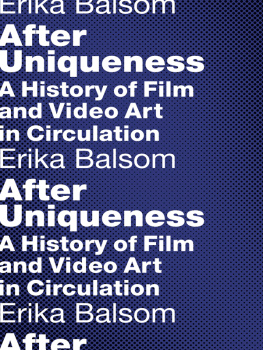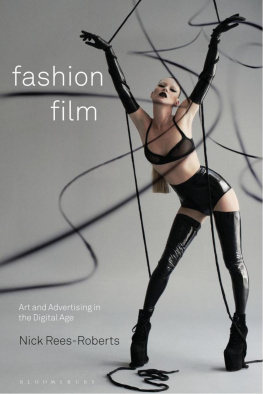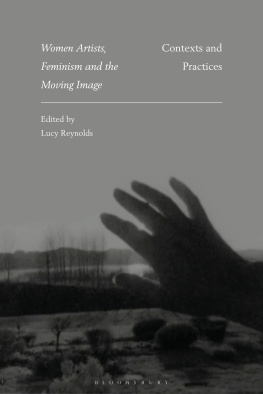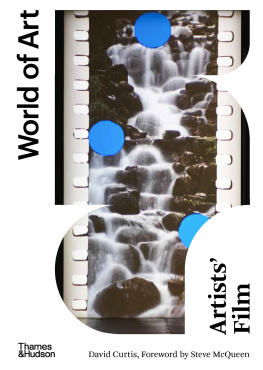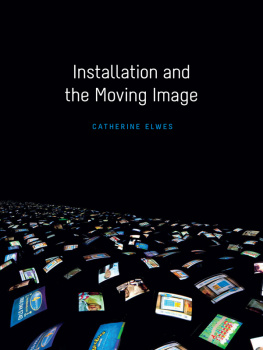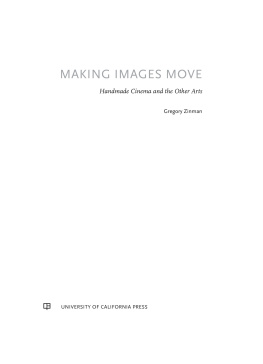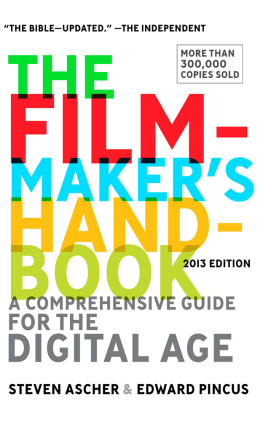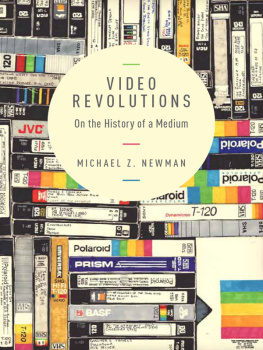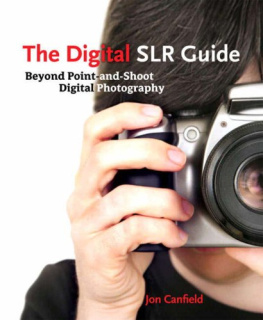Table of Contents
After Uniqueness
Film and Culture
Film and Culture
A series of Columbia University Press
EDITED BY JOHN BELTON
For a complete list of books in this series, see .
After Uniqueness
A History of Film and Video Art in Circulation
ERIKA BALSOM
Columbia University Press
New York
Columbia University Press
Publishers Since 1893
New York Chichester, West Sussex
cup.columbia.edu
Copyright 2017 Columbia University Press
All rights reserved
E-ISBN 978-0-231-54312-5
Library of Congress Cataloging-in-Publication Data
Names: Balsom, Erika, author.
Title: After uniqueness : a history of film and video art in circulation / Erika Balsom.
Description: New York : Columbia University Press, [2017] | Series: Film and culture | Includes bibliographical references and index.
Identifiers: LCCN 2016040252 | ISBN 9780231176927 (cloth : alk. paper) | ISBN 9780231176934 (pbk. : alk. paper) | ISBN 9780231543125 (e-book)
Subjects: LCSH: Motion picture audiencesHistory. | Video artHistory. | Motion pictures and the arts. | Art and motion pictures. | Motion picture industryTechnological innovations.
Classification: LCC PN1995.9.A8 B35 2017 | DDC 302.23/43dc23
LC record available at https://lccn.loc.gov/2016040252
A Columbia University Press E-book.
CUP would be pleased to hear about your reading experience with this e-book at .
Cover design: Lisa Hamm
Contents
I didnt know it at the time and Im sure he will be surprised to hear it, but this project began with a comment Phil Rosen made on a dissertation chapter of mine many years ago. Thank you, Phil, for pointing me beyond the PhD and preparing me so well for what came after.
This book took shape with support from an Andrew W. Mellon Postdoctoral Fellowship in Film and Media at UC Berkeley and developed further with a junior faculty research grant at Carleton University and an Insight grant from the Social Sciences and Humanities Research Council of Canada. Research at the Temenos Archive was supported by a small research grant from the Faculty of Arts and Humanities at Kings College London. Workshops supported by the Danish Council for Independent Researchfunded project The Power of the Precarious Aesthetic, led by Arild Fetveit, were central to the development of . A residency on Fogo Island supported by Fogo Island Arts allowed time for writing and reflection, particularly on questions of authenticity. Thank you to Gareth Long for first getting me to Fogo and to Zita Cobb, Jack Stanley, and Iris Stnzi for the opportunity to go home in a way I never anticipated.
Many friends and colleagues have been endlessly generous and helpful during the writing of this book. In London, I feel very fortunate to be a part of two inspiring communities that have deeply shaped this research: the Department of Film Studies at Kings College London and a broader network of colleagues invested in artists moving image. I am grateful to those of you near and far who have offered your time and knowledge, given me tips, answered my random questions, invited me to present this work, read drafts, and participated in many thought-provoking conversations. Thank you to Lisa Akervall, Sam Ashby, Marcos Bastos, Thomas Beard, Mark Betz, Franois Bovier, Enrico Camporesi, Francesco Casetti, George Clark, Ben Cook, Amanda Donnan, Cate Elwes, Christine Evans, Ted Fendt, Arild Fetveit, Seb Franklin, Luke Fowler, Ren Gimpel, Loren Glass, Leo Goldsmith, Johanna Gosse, Malini Guha, Josh Guilford, Andr Habib, Malte Hagener, Ed Halter, Vinzenz Hediger, Nanna Heidenrach, Birgit Hein, Nathan Holmes, Eli Horwatt, Steven Jacobs, Shanay Jhaveri, Omar Kholeif, Dan Kidner, Kim Knowles, Andy Lampert, Isla Leaver-Yap, Phil Leers, Erica Levin, Andrea Lissoni, Frances Loeffler, Owen Lyons, Gabriel Menotti, Adeena Mey, Patricia Moran, Maja Naef, Maria Palacios Cruz, Vida Panitch, Colin Perry, Alexia Petsalis-Diomidis, Michele Pierson, Emily Pillinger, Steve Polta, Jonathan Pouthier, Filipa Ramos, Lucy Reynolds, David Richler, Ben Rivers, Ben Russell, Rebekah Rutkoff, Susanne Saether, Sara Saljoughi, Herb Schellenberger, Zach Seely, Marc Siegel, Michelle Silva, P. Adams Sitney, Antonio Somaini, Mike Sperlinger, Derek Sullivan, Tess Takahashi, Mark Toscano, Jonathan Walley, Mark Webber, Federico Windhausen, Kevin Wynter, and Michael Zryd.
I am extremely grateful for the assistance of the archivists and archives that made this research possible, including the Archives of American Art; the Bancroft Library at the University of California, Berkeley; Bradley R. Arnold at the University of Colorado, Boulder; Steven Ball at the Artists Film and Video Study Collection at Central St. Martins; Robert Beavers at the Temenos Archive; Paolo Cherchi Usai and Jared Case at George Eastman House; Nicole C. Dittrich at Syracuse University; Robert Haller at Anthology Film Archives; Mark Paul Meyer at Eye Film Museum; and M. M. Serra at the Film-Makers Cooperative in New York. Thank you to Daniel Feinberg at Marian Goodman Gallery, Chris Rawson at David Zwirner Gallery, and Cristen Sperry-Garcia at Bill Viola Studio LLC for responding to my queries regarding editioning.
Thanks, as always, to my parents. This book is for Mike and Marcel.
The history of art is the history of copy rites, of transformations that take place during acts of copying.
Hillel Schwartz, The Culture of the Copy
), the kind one might expect to find at the entrance to an old-fashioned movie theater. The basement of the building housed a further sixteen of these constructions, each one a unique iteration of the same basic vocabulary, each blinking and buzzing at its own rhythm to create a cacophonous spectacle. The relatively outmoded lighting techniques of neon tubing and incandescent bulbs produced a quality of light strikingly different from the low-intensity glare of digital screens on view elsewhere in the exhibition and ubiquitous in our lives. In the basement installation the marquees no longer stood at thresholds, as they usually do, but were crowded together in a single, converged space. They were shorn from the architectural forms that have historically supported them and arrayed all across the ceiling, much closer together than they would normally be, forced to compete for the attention that it is their mandate to attract. Even though it stood alone, the marquee on the Palaiss facade was also far from where one might have expected it: rather than at the entrance to a cinema, it was positioned over the doorway of a contemporary art institution.

